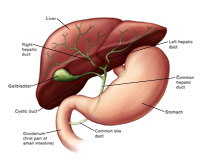Biliary System Anatomy and Functions
The Biliary System: Anatomy and Functions
Anatomy of the biliary system
The biliary system consists of the organs and ducts (bile ducts, gallbladder, and associated structures) that are involved in the production and transportation of bile.
The transportation of bile follows this sequence:
When the liver cells secrete bile, it is collected by a system of ducts that flow from the liver through the right and left hepatic ducts.
These ducts ultimately drain into the common hepatic duct.
The common hepatic duct then joins with the cystic duct from the gallbladder to form the common bile duct. This runs from the liver to the duodenum (the first section of the small intestine).
However, not all bile runs directly into the duodenum. About 50% of the bile produced by the liver is first stored in the gallbladder. This is a pear-shaped organ located directly below the liver.
Then, when food is eaten, the gallbladder contracts and releases stored bile into the duodenum to help break down the fats.
Functions of the biliary system
The biliary system's main function includes the following:
To drain waste products from the liver into the duodenum
To help in digestion with the controlled release of bile
Bile is the greenish-yellow fluid (consisting of waste products, cholesterol, and bile salts) that is secreted by the liver cells to perform 2 primary functions:
To carry away waste
To break down fats during digestion
Bile salt is the actual component that helps break down and absorb fats. Bile, which is excreted from the body in the form of feces, is what gives feces its dark brown color.



